Japan
Wood Products Prices
Dollar Exchange Rates of 10th
February 2016
Japan Yen 113
Reports From Japan
Slight year on year improvement in confidence
Data from Japan’s Cabinet Office is showing that the
consumer confidence index improved slightly in January.
The overall index rose to 42.1 while the willingness to buy
durable goods also rose very slightly.
Compared to a year earlier the January 2016 data reflects a
slightly more positive mood on the part of consumers
however, all the indices are well below 50 which is the
dividing line between positive and negative sentiment.
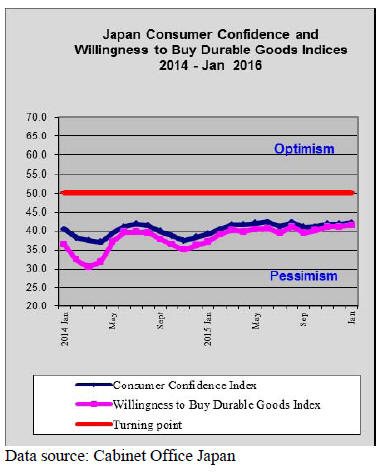
The Japanese government has kept its assessment of
the
economy at “recovering moderately” and this was borne
out by an improvement in the job market.
It is unlikely the positive mood will prevail however as the
yen strengthened sharply in the first weeks of February
threatening the profitability of exporters. A massive wave
of yen buying forced up the yen from around 120 to the
US dollar to 112 to the dollar at one point during the
second week of February.
Fears on the direction of the global economy exacerbated
by slowing growth in China and plummeting oil prices
have driven money to the yen as a safe haven.
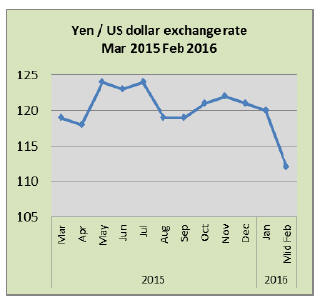
Japan’s furniture import trends
Production and sales have been shrinking in Japan’s
domestic wooden furniture manufacturing sector for more
than a decade. Most of the decline is due to competition
from imports and the inability of local manufacturers to
upgrade their processing methods and raise productivity.
Wooden furniture imports continue to gain market share; it
has been estimated that imports of bedroom, kitchen and
dining-room furniture accounted for around 60% of the
market in 2015. The growth in imports from China and
Southeast Asian countries continues to hollow out
domestic wooden furniture manufacturing.
The figure below shows trends in housing starts and
imports of wooden office, kitchen and bedroom furniture.
At first sight there appears to be a contradictory inverse
relationship between trends in housing (falling) and
imports (rising). Rather than a statistical anomaly,
however, this reflects the rapid growth in the market share
captured by imports.
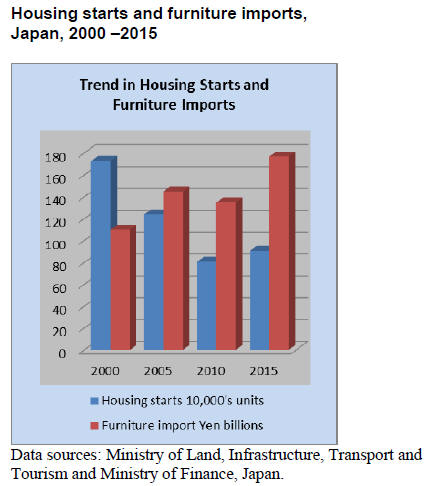
The Japanese furniture market was worth around yen
900
billion in 2005, and imports of wooden office, kitchen and
bedroom furniture accounted for about 16% of all
domestic sales. By 2015, the size of the market had fallen
to around yen 700 billion, and imports accounted for over
25% of the market.
Data from Japan’s Ministry of Internal Affairs and
Communications show that purchases of wooden chests of
drawers, a main item in the traditional “bridal furniture
set”, have dropped dramatically over the past 15 years. On
the other hand, household spending on dining-room
furniture has been fairly stable—although relatively small
compared with spending on bedroom items.
In the past, the bridal market was a main driver of growth
in Japan’s furniture sector. It was usual for the bride’s
family to buy a three-piece furniture set consisting of a
wardrobe, a Japanese-style chest of drawers, and a
dressing table.
Today, the traditional dressing-table has been replaced by
western-style chests of drawers and, because many newly
built houses and apartment have built-in closets, demand
for free-standing wardrobes has faded. This, combined
with the decline in the number of marriages, has upended
the established demand patterns for wooden furniture in
Japan.
Bedroom furniture
China’s exports of bedroom furniture to Japan accounted
for 57% (by value) of all wooden bedroom furniture
imports in 2015. The second-ranked supplier last year was
Viet Nam, with 28% of all imports, and other Southeast
Asian countries made up around 8%. The combined
market share of these three suppliers in 2015 was over
90%, the balance coming mainly from Europe and North
America.
Kitchen furniture
Fitted kitchens are now a standard feature of newly
constructed houses and apartments, and the replacement
kitchen market is growing strongly as owners of existing
homes embrace renovation to avoid the cost of demolition
and rebuilding (once a feature of the Japanese housing
sector).
In the early days of kitchen modernization, European and
North American makers of kitchen units and cabinets
found a ready market in Japan. It took suppliers in Asia
only a short time to grasp the opportunity, however, and
they began growing their market share.
Manufacturers of kitchen furniture in Viet Nam have
secured a significant part of the market (41% in 2015), as
have shippers in Indonesia, Malaysia and Thailand.
Demand for European kitchen furniture tends to focus on
German and Italian lines in the up-market housing sector.
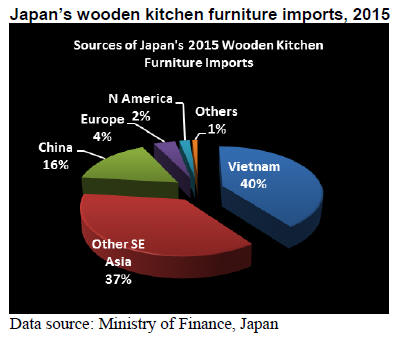
Hollowing out the furniture manufacturing base
Japan’s domestic furniture manufacturing sector has
declined as Japanese companies—even small and
medium-sized companies—have shifted production
outside Japan to countries where production costs are
lower, populations are growing and there is good
infrastructure and communications. In Japan’s wooden
furniture market, relocated Japanese companies are
responsible for much of the export trade from China and
Southeast Asia to Japan.
China was once the preferred destination for relocating
Japanese companies—it is close to Japan and has good
shipping connections. Moreover, wages and energy costs
have been much lower than in Japan, and domestic
demand has grown rapidly. This has now changed,
however: rising wages, labour disputes, and the reemergence
of bitter historical issues are causing many
Japanese companies to look elsewhere for their
investments.
Viet Nam has attracted Japanese companies, and the trade
relationship between the two countries is very close. Viet
Nam’s overall exports to Japan are now almost 10% of all
its exports, ranking second after North America. The main
products exported to Japan are garments, seafood, wood
products and electronics. In 2015, around 1000 Japanese
companies had production capacity in Viet Nam.
Expansion of single person homes creates
opportunities
Trends in Japan’s housing sector are central to the future
of the furniture manufacturing sector (whether domestic or
off-shore). Japan’s population is aging and shrinking due
to a low birth rate. The population peaked in 2005; the
number of households is increasing for now but is
projected to decline after 2019. The number of people
aged over 65 years is expected to level off in 2025 and
decline from 2040.
Superimposed on these trends is the expectation that the
population of greater Tokyo, which is rising, will begin to
fall in about ten years, when the number of households
will also begin to fall.
The other major force to influence furniture demand is the
current upward trend in one-person households, driven by
changes in culture and lifestyles, which should peak in
2030. Young professionals are shying away from early
marriage in order to focus on their careers. Since 1973
there has been a 33% decline in the number of people
getting married; moreover, the divorce rate is rising fast.
As the numbers of divorcees and never-married adults
increase, single-person households are the fastest-growing
household group and will eventually become the largest
such group in Japan. Singles need less space and can
therefore save on rent and house-building costs.
When space is limited, furniture needs to be both pleasing
and practical. Storage cabinets are popular among singles
in small homes, and many guides to living in small
spaces—with a focus on storage techniques—are
available.
Demolish and rebuild or renovate
Typically in Japan, detached wood-frame homes around
30 years old are considered worthless by lenders and by
those looking to buy. This rapid depreciation is more a
reflection of tradition than the soundness of residences,
however—homeowners in Japan were raised to believe
that wood-frame homes do not last and must be
demolished and replaced.
Understanding the extravagant waste of resources such a
tradition has created, the Japanese government has
introduced measures to encourage lenders to place a value
on renovated homes and apartments and extend the
depreciation of homes to around 50 years. The house and
apartment renovation market is booming as small,
medium-sized and even major developers are realizing its
potential.
Room for innovation and creativity
There is potential for segments of the Japanese furniture
market to grow, especially for competitively priced items
designed for singles in small spaces, such as drawers,
cabinets, fold-away dining tables and dining chairs.
Manufacturers offering a range of styles—from traditional
Japanese to Scandinavian—will find an ideal market base
if the focus is on the tasteful use of colour and simple
designs at reasonable prices.
Japanese consumers have always been rather predictable
and generally looked on low-priced goods with disdain,
preferring to shop in recognized national-brand stores and
outlets and prepared to pay for quality.
Now, however, they have started behaving like their
overseas counterparts, who for years have enjoyed
discount stores (including, in recent years, online stores)
finding low priced, serviceable items that will last until
individual tastes or fashion dictate replacement.
This fundamental shift in the attitudes and behaviour of
Japanese consumers has been reinforced by the current
state of the national economy and the impact this is having
on incomes and job security. It is likely to continue, even
when the country’s economic prospects eventually
improve.
Trade news from the Japan Lumber Reports (JLR)
For the JLR report please see:
http://www.nmokuzai.
com/modules/general/index.php?id=7
North American log and lumber import in 2015
According to tallying organizations’ rough estimated
record, log import from the North America in 2015 was
2,444,000 cbms, 19.8% less than 2014. This is sizable
drop compared to the lumber import.
Based on the Japan Lumber Importers Association’s
records lumber imports from the North America for the
first eleven months was 2,089,000 cbms, only 1.4% less
than 2014. The largest reason of decreased log import is
drop of Douglas fir log demand by plywood mills in 2015.
Plywood mills had production curtailment program last
year so that log demand declined considerably.
Actually, log import from Canada in 2015 dropped more
than 30%. Canadian Douglas fir logs are mainly used by
plywood mills in Japan. Market of Canadian Douglas fir
logs for lumber manufacturing has been steady as the
supply got tight since late last year so the prices remain
firm. Inquiries from plywood mills continue dull and slow.
This is two straight years to show decline of log import
from North America.
Increasing import of fuel for biomass generation
After Japan’s FIT system (fixed price purchase system for
renewable energy) started in 2012, many wood biomass
power generation plants started and import of fuel is
rapidly climbing.
Wood pellet and PKS (palm kernel shell) are two main
items then import of wood chip unsuitable for paper
making is expected to increase largely from now on.
Import of wood pellet for the first eleven months of 2015
was 180,863 ton, 104.1% more than the same period of
2014. By source, 113,874 ton from Canada, 37.4% more
than 2014 and 47,055 ton from China.
At present, the main users of imported wood chip is major
electric power companies, which use wooden fuel with
coal burning to reduce emission of CO2. Domestic
production of wood pellet in 2014 was 126,035 ton, 14.5%
more than 2013.
Plywood
Shipment of domestic softwood plywood continues busy.
Increasing shipment for precutting plants has continued
since last fall and the direst supply from the manufacturers
got tight in last December and precutting plants looked for
plywood in wholesale channels so the wholesalers are now
anxious to secure the volume.
Actually precutting plants made trade of necessary items
among them in December. Delivery period from the
manufacturers to precutting plants was uncertain last year
but now orders placed in early this month are promised to
be delivered by the end of this month.
Operations of precutting plants will was busy until end of
January but they seem to slow down compared to real
busy December so plywood demand will not be as busy as
before then.
Import plywood market continues bearish. The movement
of imported plywood has been slow since last August then
the importers and wholesalers reduced the prices to move
the inventories in December but the demand for imported
plywood is considerably reduced so the users are in no
hurry to procure. They would rather wait until discount
sale comes and purchase is very limited to immediate
needs only.
Therefore, if the prices are lowered, the inventories can be
moved. The importers are anxious to move the inventories
before book closing in March but decision is hard since
discount sale means to lose money. The prices have
steadily been dropping little by little.
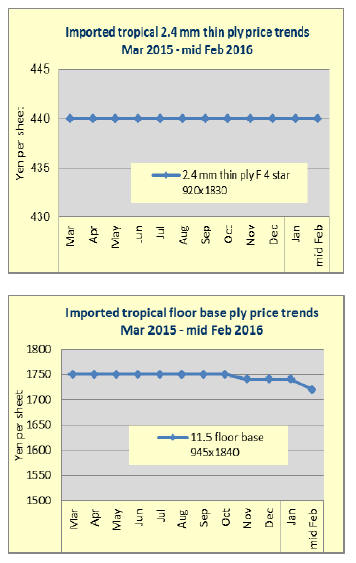 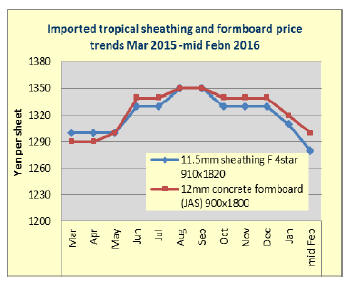
Sumitomo Forestry bought out American house
builder
Sumitomo Forestry Co., Ltd. (Tokyo) announced that it
bought 60% of share of DRB Enterprises, which owns
Dan Ryan Builders (DRB) group in Maryland. DRB is a
major house builder on the East Coast and South of the
United States. Purchase amount is about 10 billion yen.
New housing starts in Japan will continue declining by
dropping birth rate and aging of the population so
Sumitomo Forestry has been developing housing business
in foreign countries and by capital participation to the
DRB, it intends to be one of top builders in the States.
DRB is middle class builder to sell units built for sale in
six states of Maryland, Pennsylvania, Virginia and others
with annual sales of 1,248 units or 295 million dollars in
2014 and is ranked as 35th in the States. Employees are
299.
Sumitomo Forestry has been developing housing business
through Henry U.S.A. group, Gehan Homes group and
Bloomfield Homes group mainly in the West and the
South of the States. Now with DRB is under wing, the
East and the South are covered. Sumitomo Forestry plans
to have about 5,000 units of house sales in the States then
with house sales in Australia, total overseas houses would
be about 8,000 units.
Nihon Flush expands sales in China
Nihon Flush Co., Ltd. (Tokushima prefecture) plans to
increase sales to marketing agents of building materials in
China.It has 30 marketing agents in China and it plans to
expand sales with its brand ‘Nichimon’.
The company manufactures and markets systemized
building materials like interior doors and have been
supplying materials to large developers like China Vanke
Co., Ltd.Present sales amount in China is about eight
billion yen, which is about 60% of the company’s total
sales amount.
Supply to large developer like Vanke gives reliability of
the products and there are more requests from other
companies to have business with Nihon Flush so the
company decided to expand the more sales in China. In
two to three years, the sales amount in China would be as
big as 10 billion yen.
|